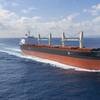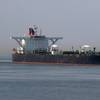Dry-bulk cargo movement on the Great Lakes totaled 162.3 million net tons in 2002, a decrease of 1.4 percent compared to 2001 and a drop of 6 percent compared to the 5-year average. Iron ore shipments totaled 58.9 million net tons in 2002, an increase of 5.8 percent compared to 2001, but a decrease of 9.2 percent compared to the 5-year average. North American raw steel production totaled an estimated 101.7 million tons in 2002, an increase of 2.4 percent compared to 2001, but the amount of steel made in Basic Oxygen Furnaces that turn pellets into hot metal fell 4 percent to an estimated 50.1 million net tons. The Lakes iron ore trade was essentially non-stop in 2002. Shipments ceased from Lake Superior ports when the Soo Locks closed on January 15, but Escanaba continued to ship throughout February, albeit at a much slower pace, as the iron ore was being railed down from the Minorca Mine in Minnesota. The Mesabi Range ore was then loaded into the tug/barge unit Joyce Vanenkevort/Great Lakes Trader. The March 25 opening of the Soo Locks allowed the Lake Superior iron ore trade to resume in earnest, but for the first time in 45 years, Taconite Harbor remained silent. The iron ore mine that shipped through "Tac Harbor" ceased operations in January 2001 and the dock has not loaded a cargo since August of 2001. The March, April and May totals from U.S. ports represented significant declines from the year before and reflected the continued idling of mills operated by the now bankrupt and liquidating LTV Steel. Those mills were purchased by investors who then founded the International Steel Group (ISG). Steel production resumed in Cleveland in late May and Indiana Harbor in July. Monthly iron ore shipments from U.S. and Canadian ports peaked at 7 million net tons (6.2 million gross tons) in August and remained ahead of 2001's pace through the end of the year. Coal shipments totaled 41.9 million net tons in 2002, a decrease of 5.5 percent compared to 2001, but essentially on track with the 5-year average. The decrease was almost entirely the result of reduced demand for eastern coal shipped from Lake Erie ports. Loadings at Toledo, Sandusky, Ashtabula and Conneaut slipped below 20 million tons, a decrease of 15.5 percent compared to 2001 and 10.9 percent below the 5-year average. High inventories at Canadian powerplants lessened demand for Lake Erie coal. On the other hand, Superior Midwest Energy Terminal (SMET) had another banner year. Its shipments of low sulfur coal topped 18 million tons. While this tally represents an increase over 2001 and the 5-year average, its real significance is that the dock has now set a new record for annual shipments 9 years in a row. SMET also set a new record for the most coal to be shipped by a single dock in one month when it loaded 2,548,173 net tons in July. The previous record dated back 46 years to October 1946 when the Chesapeake & Ohio dock in Toledo handled 2,468,619 net tons of coal. Coal loadings at South Chicago decreased by four or five boatloads compared to 2001, but topped the dock's 5-year average by the equivalent of one cargo. The Lakes limestone trade totaled 36.2 million net tons in 2002, a decrease of 1.6 percent compared to 2001 and a drop of 3.3 percent compared to the 5-year average. The trade might have finished about even with 2001, but vessels in the stone trade experienced significant weather delays in November. Two factors largely determine demand for limestone - steel production sets the level of fluxstone shipments and construction activity drives demand for aggregate. Steel's problems have been well documented. Basin-wide, the construction industry was sluggish; some major markets saw a significant slowing in new construction projects. Salt shipments totaled 7.2 million net tons in 2002, a decrease of 6 percent compared to 2001but essentially on par with the 5-year average. Some decrease was expected given the mild winter of 2001/2002, but a strike at the salt mine in Cleveland also impacted the trade. The Lakes cement trade totaled 5.3 million net tons in 2002, a slight decrease from 2001 and the 5-year average.
Demand for cement is obviously based on the level of construction in the Great Lakes basin and as explained in the Limestone Section, 2002 saw a general sluggishness and marked declines in some major markets. The Lakes potash trade remained stagnant in 2002. Shipments from Thunder Bay, Ontario (the sole potash loading port on the Lakes) totaled 587,296 net tons, an increase of one boatload compared to 2001.
Subscribe for
Maritime Reporter E-News
Maritime Reporter E-News is the maritime industry's largest circulation and most authoritative ENews Service, delivered to your Email five times per week










